
TNU Journal of Science and Technology
229(03): 135 - 141
http://jst.tnu.edu.vn 135 Email: jst@tnu.edu.vn
THE ROLE OF HUMAN CAPITAL
IN THE DIGITAL TRANSFORMATION ECONOMY
Tran Nhat Thien*
Dalat University
ARTICLE INFO
ABSTRACT
Received:
09/11/2023
This paper aims to study the role of human capital accumulation in the
growth of the digital transformation economy by investigating the
interplay between human capital formation and the effects of tax policies
from government spending on human beings. The research methodology
is based on endogenous growth theory with an overlapping generation
model and homogeneous economic agents. The main finding is that
public investment in enhancing the efficiency of workers results in the
economic growth of the digital transformation economy. Another is that
two effects of taxation are noteworthy: (i) taxes reduce households'
income, lowering their investment in physical capital, which hurts
output; (ii) taxation raises the public spending on human capital, thus
enhancing the efficiency of labor capacity, consequently, increasing
economic growth in digital transformation economy. The study's
conclusion is that the long-run growth rate is fueled by the investment in
human capital, and the government may levy taxes on labor income and
capital returns to finance this public investment.
Revised:
18/01/2024
Published:
18/01/2024
KEYWORDS
Human capital
Endogenous growth
Economic growth
Digital transformation
Digital economy
VAI TRÒ CỦA VỐN CON NGƯỜI TRONG NỀN KINH TẾ CHUYỂN ĐỔI SỐ
Trần Nhật Thiện
Trường Đại học Đà Lạt
THÔNG TIN BÀI BÁO
TÓM TẮT
Ngày nhận bài:
09/11/2023
Bài viết này nhằm mục đích nghiên cứu vai trò của tích lũy vốn con
người đối với sự tăng trưởng của nền kinh tế chuyển đổi số bằng cách
nghiên cứu mối tương tác giữa việc hình thành vốn nhân lực và tác
động của chính sách thuế từ chi tiêu của chính phủ đối với con người.
Phương pháp nghiên cứu dựa trên lý thuyết tăng trưởng nội sinh với
mô hình thế hệ chồng chéo và các cá nhân đồng nhất. Phát hiện chính
của nghiên cứu là khi tăng đầu tư công vào việc nâng cao hiệu quả của
người lao động sẽ thúc đẩy tăng trưởng kinh tế của nền kinh tế chuyển
đổi số. Một kết quả khác đó là có hai tác động đáng chú ý của thuế: (i)
thuế làm giảm thu nhập của hộ gia đình, giảm đầu tư vào vốn vật chất,
làm tổn hại đến sản lượng; (ii) thuế làm tăng chi tiêu công cho vốn con
người để nâng cao hiệu quả năng lực của lao động, từ đó thúc đẩy tăng
trưởng kinh tế trong nền kinh tế chuyển đổi số. Kết luận của nghiên
cứu là tốc độ tăng trưởng dài hạn được thúc đẩy bởi đầu tư vào vốn
con người và chính phủ có thể đánh thuế trên thu nhập lao động và lợi
tức vốn để tài trợ cho khoản đầu tư công này.
Ngày hoàn thiện:
18/01/2024
Ngày đăng:
18/01/2024
TỪ KHÓA
Vốn con người
Tăng trưởng nội sinh
Tăng trưởng kinh tế
Chuyển đổi số
Nền kinh tế số
DOI: https://doi.org/10.34238/tnu-jst.9172
*Email: thientn@dlu.edu.vn

TNU Journal of Science and Technology
229(03): 135 - 141
http://jst.tnu.edu.vn 136 Email: jst@tnu.edu.vn
1. Introduction
The relationship between human capital and economic growth progress was re-awakened in
the late 50s and early 60s of the twentieth century. Horvat [1, p. 748] introduces the concept of
human capital and the important of “human factor”. Horvat [1, pp. 751-752] also asserts that a
human stock depends on four elements: “personal consumption, health, knowledge, and
economic and political organization”. The embodiment of the “human factor” into the concept of
capital is also explained by Kiker [2], and Spengler [3]. These authors indicate that the
investment in human capital raises productivity and thus adds to “national wealth.”
The workhorse model of Solow [4], [5] has afforded a point of starting from which to explore
the contribution of human capital in the context of endogenous growth as an input in production
process. This context has become known as the human capital-extended Solow's model as
revisited by Mankiw et al. [6], using the production function with three input factors: physical
capital, human capital and labor. These findings then introduces the standard of the skeletal
seminal model of Lucas [7] to highlight one of the most popular evolutions of human capital
within the economic growth process.
Research on human capital formation and its impacts on economic growth is shed light on the
seminal article of Lucas [7]. According to Lucas's contribution, human stock is represented as the
nature of capital and the attribute of externalities generated by human stock accumulation. In
particular, education and training would affect the productivity not only of the individuals
accumulating knowledge but also of their co-workers as a social capital in an economy.
Thenceforth, human capital accumulation is placed at the center of economic growth progress
[7] – [11]. More recently, Lucas [12] again emphasizes the role of human capital accumulation
and its impact on the economic growth process, along with external sources, like new technology.
Many famous quantitative studies have also demonstrated the importance of human capital for
economic growth and development. Schoellman [13, p. 411], in the investigation of schooling
quality, indicates that “differences in education quality are roughly as important as differences in
year of schooling in accounting for the difference in output per worker across countries”.
Manuelli [14], using data on schooling and age-earnings profile, discovers that differences in
quality of human capital rather than differences in levels of the “total factor productivity” better
explain differences between countries in “average income.” Galor and Moav [15, p. 1004] also
suggest that the physical and human capital may compete with each other in order to be the
source of economic growth.
This research is in the spirit of Aghion, Akcigit & Howitt who discover the [16]
“Schumpeterian growth theory” by developing models based on this theory. These models shed
light on many aspects of the economic growth process: (i) the role of “competition and market
structure”; (ii) “firm dynamics”; (iii) the nexus between “growth and development” with the role
of institutions; (iv) the relationship between growth process and “long-term technological
waves”. This article will relate to the fourth aspect where the growth of digital transformation
economy results from innovation via the investment in human capital.
The main idea runs as follows. The research considers an overlapping generation model with
homogeneous economic agents. The agents live in two periods: Young agent is denoted by date
t
,
Old agent by date
1t
. Agents work when young with inelastic working time. Young agents
make decision on consumption and investment in physical capital and consume what they get
from savings when old. Besides, this study is also in line with the model of Barro [9], where the
fund of public investment in human capital for the economic growth of digital transformation
economy financed by collecting taxes from labor and capital income.
The main finding is that by increasing the fraction of public investment in enhancing the
efficiency of workers via enhancing the economic growth of digital transformation economy.
Another is that two effects of taxation are noteworthy: (i) taxes reduces households' income,

TNU Journal of Science and Technology
229(03): 135 - 141
http://jst.tnu.edu.vn 137 Email: jst@tnu.edu.vn
lowering their investment in physical capital, which has a negative impact on output; (ii) taxation
raises the public spending on human capital, thus enhancing the efficiency of labor capacity,
consequently, increasing economic growth in digital transformation economy.
The remainder of the paper proceeds as follows. Section 2 shows the research methodology.
Section 3 is the results and discussion by indicating the balance of growth path finding and the
fiscal policy placed into overlapping generations economy. Section 4 is the conclusion.
2. Research methodology
t
This study considers an economy with overlapping generations model where at each time ,
t
N
the population of the newborn cohort is . The demographic growth rate is assumed to be a
1t
t
N
nN
1n
constant and .
This model allows for physical and human capital accumulation. It turns out that young agents
work and spend their labor income on consumption and investment in physical capital
accumulation. Old agents do not work but only consume.
2.1. Production
In each period, a representative firm uses physical capital and labor to maximize profit. The
economy's technology is launched by the Cobb-Douglas production function:
1
( , )
t t t t
F K L AK L
t
K
t
L
, where the share of is between zero and one; and are
A
respectively the demand of firm for capital and labor. is the productivity.
t
K
t
L
A representative firm chooses and to maximize its profit
1
max [ ]
t t t t t t
AK L R K w L
(1)
At optimum, the prices of capital and labor of the economy are
(1 )
t t t
w AK L
(2)
11
t t t
R AK L
(3)
2.2. Consumers
t
N
t
1tt
N nN
1n
Suppose that new borns at each date , with , . Each individual maximizes
, , 1
ln ln ,
i t i t
cd
her intertemporal utility with the function under the following constraints
(1 ) ,
t t t t
c s w h
11
(1 ) ,
t k t t
d R s
where
t
c
,
1t
d
are respectively consumption of an individual when young and old;
t
s
is her
saving for investment in capital,
t
h
is her labor supply when young.
,
k
are respectively the
constant taxation rates on labor income and capital returns.
Lemma 2.1. For each agent, the economy yields
1(1 ) ,
1
t t t
c w h
(4)
(1 ) ,
1
t t t
s w h
(5)
11
(1 ) .
t k t t
d R s
(6)

TNU Journal of Science and Technology
229(03): 135 - 141
http://jst.tnu.edu.vn 138 Email: jst@tnu.edu.vn
Proof.
The Lagrange equation is given by
1 1 1
ln ln ( (1 ) ) ( (1 ) )
t t t t t t t t t k t t
c d c s w h d R s
.
From first order conditions, we have
1,
t
t
c
1
,
t
t
d
1
(1 ) ,
t k t t
R
which leads to
1
1
(1 ) .
tt
kt
tt
dR
c
Moreover, the budget constraints are now binding, thus
11
(1 ) ,
t k t t
d R s
and then
.
tt
cs
Since
(1 ) ,
t t t t
c s w h
one has
1(1 ) ,
t t t t
s s w h
which implies
(1 ) ,
1
t t t
s w h
1(1 ) ,
1
t t t
c w h
and
11
(1 ) .
t k t t
d R s
Market clearing conditions are as follows:
- In the physical capital market:
1t t t
K N s
(7)
- In the labor market:
t t t
L N h
(8)
1
1t t t t t t t t t
AK L N c N s N d G
Then the equilibrium in all market is , where the total
collected tax is expressed:
11t t t t k t t t
G w h N R s N
(9)
2.3. Public investment in human capital for digital transformation economy
This subsection illustrates the mechanism the fund of public investment in human capital for
the economic growth of digital transformation economy is financed by collecting taxes from
labor and capital income.
If we denote the physical capital per capita,
/
t t t
k K N
; the output per capita,
/
t t t
y Y N
, with
1
t t t
Y AK L
and the government spending per capita in human capital,
/
t t t
g G N
, then we have
1tt
s nk
, (10)
(1 )
t t t
w h y
, (11)
t t t
R k y
, (12)
[ (1 ) ]
t k t
gy
. (13)
Also, the education process for the accumulation of human capital in digital transformation
economy is supposed to be governed by
1
1(1 )
t t t t
h Bg h h
(14)
In technical equation (14),
1t
h
and
t
h
are human capital in digital transformation economy at
date
1t
and date
t
, respectively;
is the depreciation of human capital accumulation; and
B
is the parameter or productivity or quality of human capital accumulation.

TNU Journal of Science and Technology
229(03): 135 - 141
http://jst.tnu.edu.vn 139 Email: jst@tnu.edu.vn
1
( , , , , , )
t t t t t t
w c d L K G
Definition 2.1. An equilibrium is a positive sequence satisfying the
equations from (2) to (10).
2.4. Equilibrium system
Equation (5) becomes
1(1 )(1 )
1
tt
nk y
(15)
or equivalently
1
1(1 )(1 )
1
t t t
nk Ak h
(16)
Equations (13) – (16) will form the equilibrium system.
3. Results and discussion
3.1. Balance growth path (BGP) finding
Proposition 3.1 (global dynamics)
i) There exists a unique equilibrium. In the equilibrium, the global dynamic system is given by
11
.
tt
tt
k
k
h
h
1( , ) ,
k
ii) The growth rate of the economy is given by where
1
( , ) [(1 )(1 )] [(1 ) ] ,
kk
1
1
1.AB
n
Proof.
i) The equilibrium system is given by (2) - (10). Also, according to (13) - (14) and we have
the result to prove.
ii) Suppose
11tt
tt
kh
kh
, then from (14) gives
1
()
1
tt
B
hg
Combining (13) and (15) we get
1
11
[(1 ) ]
(1 )(1 )
t k t
g n k
Then, combining the two equations above, we have
1
1
11
( ) [(1 ) ]
1 (1 )(1 )
t k t
B
h n k
Combining (15) and the latter equation, we receive
11
11
11
11
(1 )(1 ) (1 )
1 1 (1 )(1
An )
t t k t
B
nk k k
11
1(1 )(1 )] [(1 )
11 k
B
n An
11
1
( 1 ) (1 )(1 ) [(1 ) ]
1k
An B
Next, taking the logarithm in two sides of the equation above, we get
( , )
()
11
ln ln( 1 ) ln ln ln ln[ ] ln(1 ) (1 ) ln[(1 ) ]
1
k
k
A n B





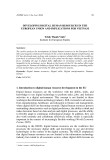
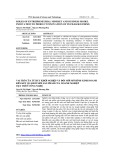
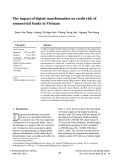
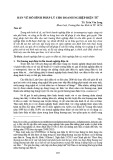
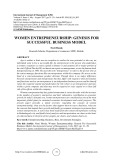
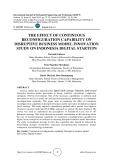












![Bộ câu hỏi trắc nghiệm Đổi mới và sáng tạo [mới nhất]](https://cdn.tailieu.vn/images/document/thumbnail/2025/20251007/kimphuong1001/135x160/56111759828894.jpg)


